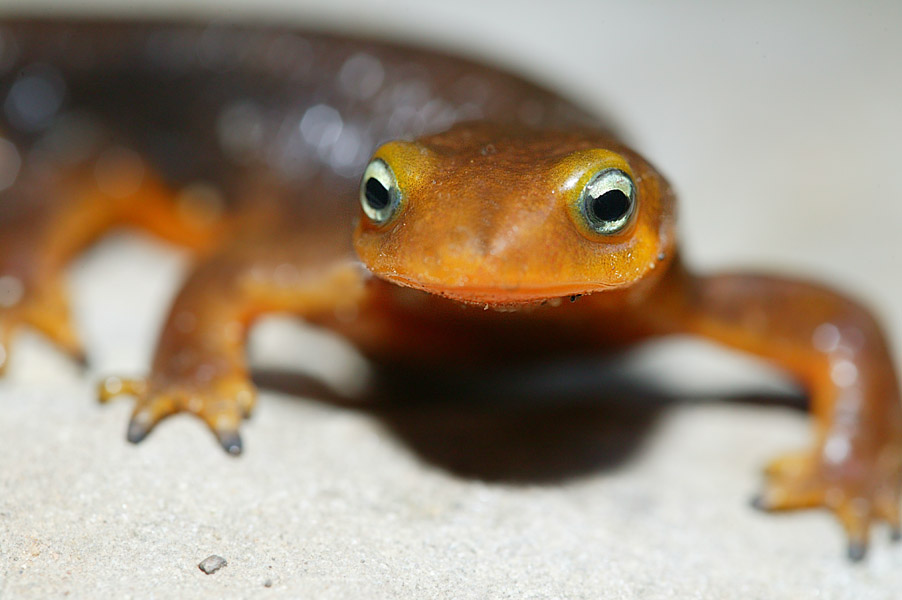| Merriam-Webster's Dictionary defines
ecology as 1) a branch of science concerned with the interrelationship
of organisms and their environments; 2) the totality or pattern of relations
between organisms and their environment We should
pause to define organism as well, since it is not a word that we
commonly use in conversation. Organisms include all life, plant life, animal
life, and of course human life. Some organisms are too small to see with
your eye without a microscope, so when we think about the interrelationships
of all organisms in a totality or pattern in a particular environment, we're
talking about a very complicated web of interactions, from the visible level
of trees, plants, and animals, to the microscopic level in the soil where,
in a healthy tablespoon of soil there are up to a million organisms!
The interesting thing about ecology, like art, is
that in an apparently chaotic environment of many forces, patterns become
visible and we start to see connections between things. For example, earthworms breaking down dead leaves to recycle into
soil for plants to use; and trees providing shelter for the squirrels while
squirrels burying nuts helps to propagate the next generation of the trees. There
are also a lot of relationships and interaction between the different
species that are affected by human populations too. For example, as the mountain lion population has decreased with
increasing human settlement in the Appalachian mountains, the population of its natural
prey, the deer, has increased. While the deer population has
increased, most animal and plant populations have decreased as extensive
suburban development has expanded further and further away from the cities
into the mountains. Visible patters within ecosystems have always changed,
but never as fast as the change that major development using powerful
earth-moving equipment. For those of us who live in the mountains, we
still have opportunities to observe some of the natural wonders of the
mountain ecology. Ecology along mountain rivers is especially interesting
because there are so many different habitats. The river winds around all
sides of the mountains, each side of the mountain providing unique habitats
for different species of plants and animals, each species interacting with the other and connected by
the river and its tributaries.
|
Art flows naturally
out of peoples' experiences living in the dynamic web of mountain and river
habitats. Cherokee Indian stories are especially rich in the way they
describe the interactions between plants, animals, and humans. Even people
who have lived here for a generation or two have exciting stories to tell.
River and mountain memories around the world are worth sharing as they're
are similarities and differences, casting each in higher relief for deeper
appreciation. World Class Learning Alliance has initiated several projects
to and stimulate further artistic reflection on data
shared. Using data collection protocols of Georgia Adopt-a-Stream, the G.L.O.B.E. program,
students in Lumpkin County, Georgia, U.S.A., and Koushu-shi,
Yamanashi-ken, Japan have exchanged data and related artwork.

1) Artwork from our
seasonal invertebrate sampling on the upper Etowah in Lumpkin County
 2)
River art from fourth graders at Ijiri
Elementary school in Yamanashi-ken Japan 2)
River art from fourth graders at Ijiri
Elementary school in Yamanashi-ken Japan
 3)
River art from Lumpkin county First Graders sent to Japan 3)
River art from Lumpkin county First Graders sent to Japan |
 Our relationship to our local and regional ecologies where we live has become scarey. It's like we are a part of a science fiction story in which humans have become aliens on our own planet, unaware that we are destroying the matrix of life on which our clean water and air depends. The desctruction of most of the traditional ecologies in many parts of the world is complete, especially in river valleys and flatlands. Destruction of the ecologies of mountainous regions of the world has been slower and there is reason to hope that some preservation is possible. The ecological and artistic activities facilitated by World Class Learning Alliance are focused primarily on the southern Appalachian Mountain region in the U.S., particularly the headwaters of the Etowah River; and, the Central mountains of Honshu in Japan. Through exchange projects of ecological data and art, we are seeking to learn from each others' ecologies and the unique relationships we each have with them. Our recent projects include river invertebrates samplings and a northern Georgia campaign to save the hemlock tree from the wooly adelgid, a devastating insect from Asia that has wiped out most of the eastern hemlocks since the late 1990s. Similarly, Japan's native habitats have faced invasive species from Europe and the Americas. Our data and art exchange projects are our attempt to learn from creative responses to challenges culturally and economically. We seek to help one another build more creative, economically-viable relationships with our respective ecosystems.
Our relationship to our local and regional ecologies where we live has become scarey. It's like we are a part of a science fiction story in which humans have become aliens on our own planet, unaware that we are destroying the matrix of life on which our clean water and air depends. The desctruction of most of the traditional ecologies in many parts of the world is complete, especially in river valleys and flatlands. Destruction of the ecologies of mountainous regions of the world has been slower and there is reason to hope that some preservation is possible. The ecological and artistic activities facilitated by World Class Learning Alliance are focused primarily on the southern Appalachian Mountain region in the U.S., particularly the headwaters of the Etowah River; and, the Central mountains of Honshu in Japan. Through exchange projects of ecological data and art, we are seeking to learn from each others' ecologies and the unique relationships we each have with them. Our recent projects include river invertebrates samplings and a northern Georgia campaign to save the hemlock tree from the wooly adelgid, a devastating insect from Asia that has wiped out most of the eastern hemlocks since the late 1990s. Similarly, Japan's native habitats have faced invasive species from Europe and the Americas. Our data and art exchange projects are our attempt to learn from creative responses to challenges culturally and economically. We seek to help one another build more creative, economically-viable relationships with our respective ecosystems.


